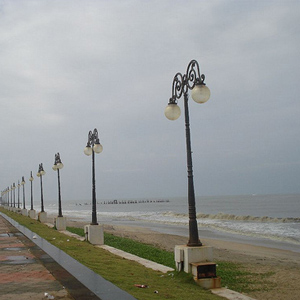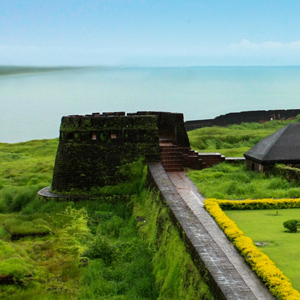A major tourist destination in North Kerala, Kozhikode has it all. Rich tradition and culture, mouth-watering delicacies, picturesque locations, you name it, Kozhikode has it all. Kozhikode was the capital of Samoothiri Dynasty. It was once a world famous trade centre and was visited frequently by Arab, French, Portuguese, the Dutch and English.
kozhikode
-
-

KOZHIKODE BEACH
Kozhikode beach is a vast pristine beach on the Malabar Coast of Kerala. The beach is of historic importance as Vasco Da Gama first landed here and also it was on the much-hailed spice route. Sunset on the beach is a spectacular sight and one get fresh seafood in the shacks. Mussels are a local favourite. There is a lion park nearby and marine water aquarium. The two 100-year-old piers jetting into the sea takes you back to the historic corridors.
-
S.M. STREET AND MANACHIRA SQUARE
Both are the busiest streets in Kozhikode today. SM street s the acronym for Sweet Meat Street. The shops in the street sell sweet as the major attraction. The street was famous for Gujarati Confectioneries in the past. An abandoned Parsi Cemetery located near the area is mentioned in William Logan's Malabar Manual.
-
MISHKAL MASJID
Constructed of timber and dating back to the 14th century the Masjid is constructed by rich Arab Trader, Nakhooda Mishkal. Considered to be of great historical and cultural monument. Made entirely out of wood the mosque has 47 doors, 24 carved pillars and a big prayer hall. This hall is adorned with elegant motifs and is well ventilated. Typical of a mosque Cupolas and minarets are absent in the structure as it is the traditional Kerala temple architecture is followed.
-
MOTHER OF GOD CATHEDRAL
The church is built by the Portuguese. The Zamorin invited them to Calicut and they subsequently built a factory and a church dedicated to Mother Mary near the beach Kozhikode. The church was built by Italian architects who were brought from Italy only for this. The year was 1742. Built in Gothic style the structure flaunts curved arches and collonaded spires. This is the testament to not only the aesthetic elegance of the Italian designers but also the Indian artisans who executed the church to its present form. A rare two-century-old portrait of St. Mary is found inside the church.
-

THE MARINE RESEARCH AQUARIUM
Built to preserve and showcase the biodiversity of the Malabar cost the place keeps over 150 varieties of ornamental fish. This was built with the objective of spreading awareness about the biodiversity of the coast among the public and the pundits alike. Thrust is given for keeping ornamental fish from the south-west coast and Lakshadweep.
-
PAZHASSI RAJA MUSEUM AND ART GALLERY
Named after the great ‘Pazhassi Raja’ the king who resisted the British the Museum has relics which tell stories of the bygone era. The building was the erstwhile collector's bungalow for the British rulers. Known as the East Hill Bungalow. The Malabar collector William Logan, who penned the Malabar Manual, resided here.
It was used as collector’s bungalow till 1976. Then it was converted to the archaeological museum. Mainly the relics excavated from different parts of Malabar are displayed here. Old coins from different kingdoms are displayed, including the ones during Arakkal Raja, Kochi, Roman Empire, Tipu Sultan and Travancore. The museum displays ancient murals, models of temples, ancient earthenware.
The paintings of the master painter Raja Ravi Varma and his uncle Raja Raja Varma are exhibited in the art gallery adjacent to the museum. Most of the paintings displayed are portraits of men and women which boast of intricate details of human anatomy.
-
VALIYANGADDI
Literally translates into the big market this is the oldest business centre in the history dating back to 600 years. This is still a prominent wholesale and retail market in Calicut. This area is marked by people from the diverse background as Gujaratis, Marwaris, Tamil and Andhra Chettis, Hindu Seths. Jain Temple, Shree Balkrishan Lalji Temple, Muthakkara Palli, Pazhavakkathu Palli and other places of worship co-exist as an example of the religious harmony of the place.
-
BEYPORE PORT AND FISHING HARBOUR
Beypore is a place of historical importance as a prominent port facilitating trade and maritime centre with Arabs, Chinese and Europeans. It was a major shipbuilding centre once. The ships built here are known by the name ‘Uru’ (Arabian trading vessel). The Arabs were the major customers. Once an order was placed the shipwrights conceive the design in their minds, not as a blueprint on paper. Then they execute it together to perfection without the use of such machinery. This practice is still followed and a ship taking place from scratch to perfection is a sight to see. The fishing harbour situated 1 Km from the shipbuilding yard.
-
KADALUNDI BIRD SANCTUARY
Some 7 km from Bepyore is Kadalundi Bird Sanctuary. The place where Kadalundi River merges with the Arabian sea a group of islands were formed. Home to more than a hundred species of local birds and some 60 species of migratory birds this is a bird watcher’s paradise. The birds are sandpipers, gulls, terns, herons, cormorants, brahminy kites, whimbrels etc. The mangrove covering the sanctuary gives protection to the otters and jackals there.
-
BEYPORE PORT AND FISHING HARBOR
The hardy dhows built in the boatyards of Beypore evoked much admiration from European seafarers and Arab traders. Called ‘dhows’ in Arabic or ‘urus’ in Malayalam, they are reputed to have played a part in the Battle of Trafalgar.
The boatyards, situated in the village of Beypore, at the mouth of the Chaliyar River, even now follow an ancient system to design the boats, later, building them entirely of wood, mostly for wealthy clients in Arab countries.
A visit to the port and boatyards in Beypore is in many aspects a journey into the past – dhows still sail serenely out into the ocean at dawn, gulls hover overhead just birds before them did for hundreds of years, and the rhythm of wood being fashioned into doughty vessels.
-
KADALUNDI BIRD SANCTUARY
Visitors will be dazzled by over a hundred species of birds both migratory and endemic in the Kadalundi Bird Sanctuary, a cluster of islands surrounded by hillocks with the Kadalundipuzha River flowing into the Arabian Sea nearby. Terns, gulls, herons, sandpipers, cormorants, whimbrels and brahminy kites, turnstones, red and greenshanks and many more flock to these shores in large numbers from November to April. Kadalundi is also known for a wide variety of fish, mussels and crabs. The mangrove vegetation here shelters otters and jackals.
-

BEKAL FORT AND BEACH
The largest and well maintained Fort in Kerala. The uniqueness of fort is that it was built specifically for defending any military attack. The fort is a classic example of the high levels of the military strategy of that time. The fort is build up from the sea on a rising terrain. The approach to the fort is a zigzag entry and the trenches all around give the best possible protections. The openings in the walls are used to keep the firearms. The ones on the outer wall facilitate aiming at the farthest. The holes below are for a mid-range strike and the ones below for a short-range firing. The fort is built with a large tank with a flight of steps. An observation tower is also present.
Apart from the large tank with a flight of steps, features of the fort worthy of note are the zigzagging paths to the entrance of the fort, trenches around the fort, a magazine, a tunnel, ports for guns at various levels on the outer walls, designed in order to enable defenders cover the entire field of fire. A tall Observation Tower offers a panoramic view of the surrounding landscape, the blue expanse of the Arabian Sea and gorgeous sunsets that are not to be missed.








